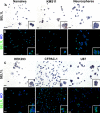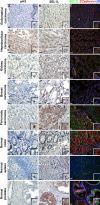Cell and tissue microarray technologies for protein and nucleic acid expression profiling
- PMID: 23172795
- PMCID: PMC3636688
- DOI: 10.1369/0022155412470455
Cell and tissue microarray technologies for protein and nucleic acid expression profiling
Abstract
Tissue microarray (TMA) and cell microarray (CMA) are two powerful techniques that allow for the immunophenotypical characterization of hundreds of samples simultaneously. In particular, the CMA approach is particularly useful for immunophenotyping new stem cell lines (e.g., cardiac, neural, mesenchymal) using conventional markers, as well as for testing the specificity and the efficacy of newly developed antibodies. We propose the use of a tissue arrayer not only to perform protein expression profiling by immunohistochemistry but also to carry out molecular genetics studies. In fact, starting with several tissues or cell lines, it is possible to obtain the complete signature of each sample, describing the protein, mRNA and microRNA expression, and DNA mutations, or eventually to analyze the epigenetic processes that control protein regulation. Here we show the results obtained using the Galileo CK4500 TMA platform.
Conflict of interest statement
Figures



References
-
- Abrahamsen HN, Steiniche T, Nexo E, Hamilton-Dutoit SJ, Sorensen BS. 2003. Towards quantitative mRNA analysis in paraffin-embedded tissues using real-time reverse transcriptase polymerase chain reaction: a methodological study on lymphnodes from melanoma patients. J Mol Diagn. 5:34–41 - PMC - PubMed
-
- Auerbach C, Moutschen-Dahmen M, Moutschen J. 1977. Genetic and cytogenetical effects of formaldehyde and related compounds. Mutat Res. 39(3–4):317–361 - PubMed
-
- Benavides J, García-Pariente C, Gelmetti D, Fuertes M, Ferreras MC, García-Marín JF, Pérez V. 2006. Effects of fixative type and fixation time on the detection of Maedi Visna virus by PCR and immunohistochemistry in paraffin-embedded ovine lung samples. J Virol Methods. 137(2):317–324 - PubMed
Publication types
MeSH terms
Substances
LinkOut - more resources
Full Text Sources

